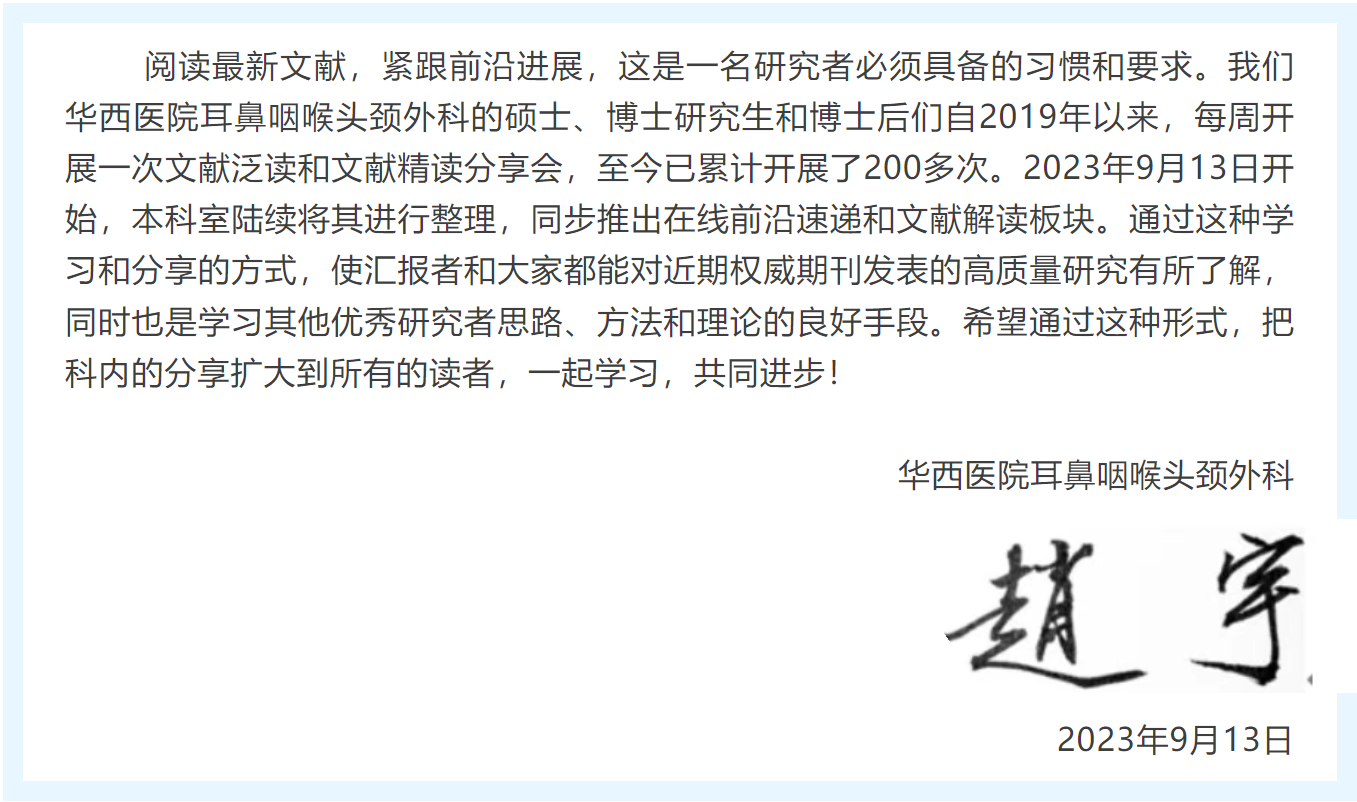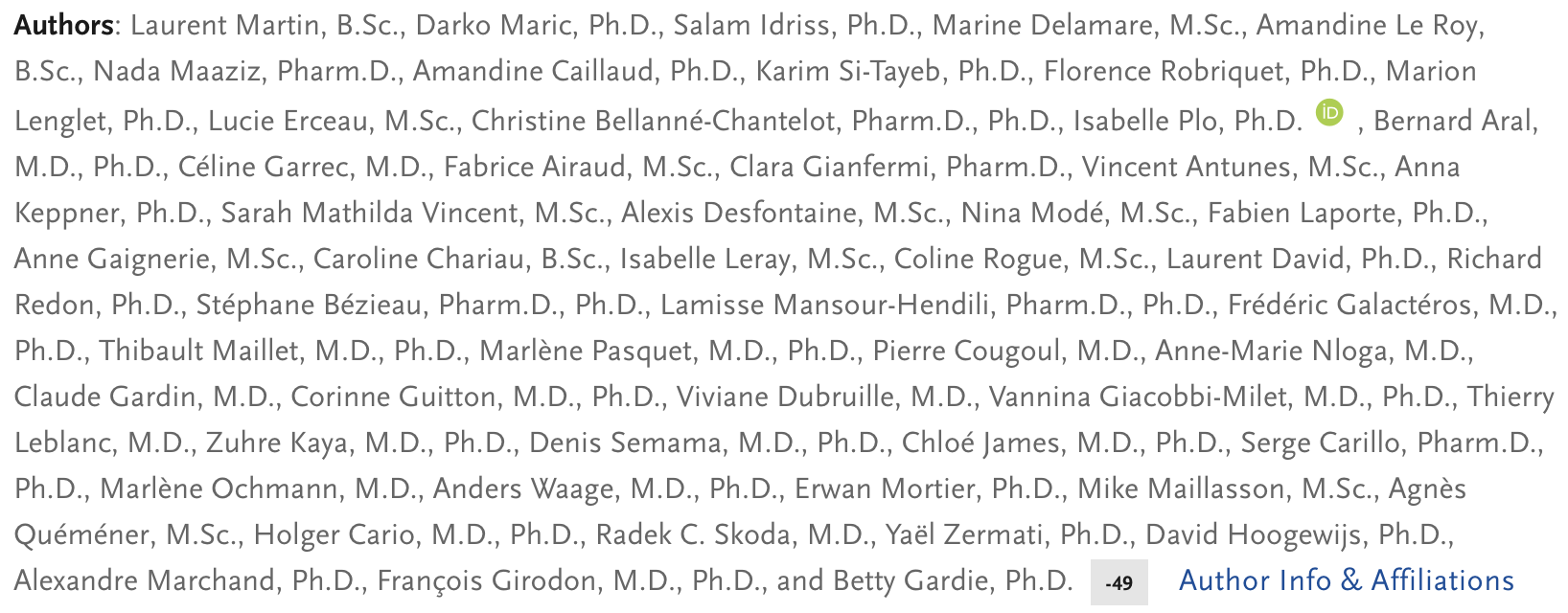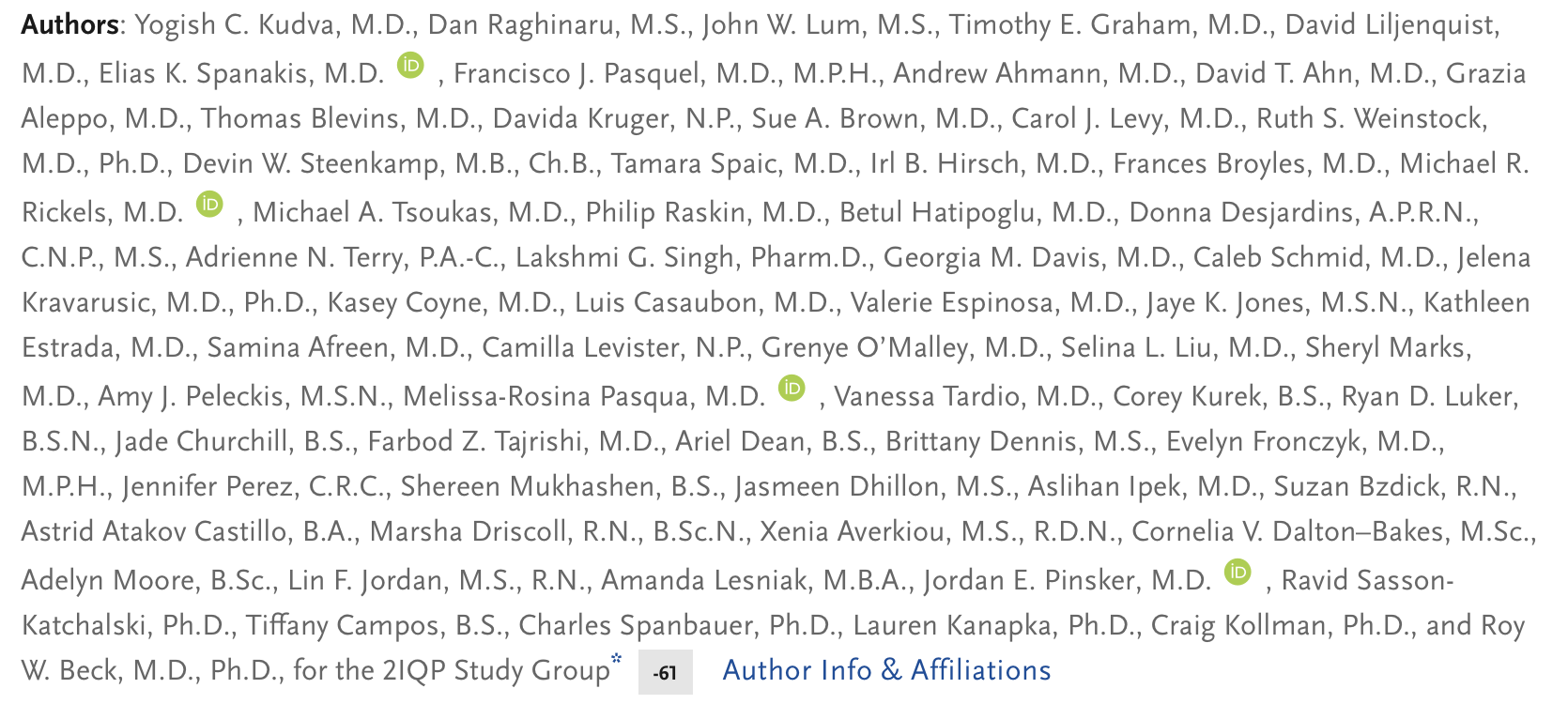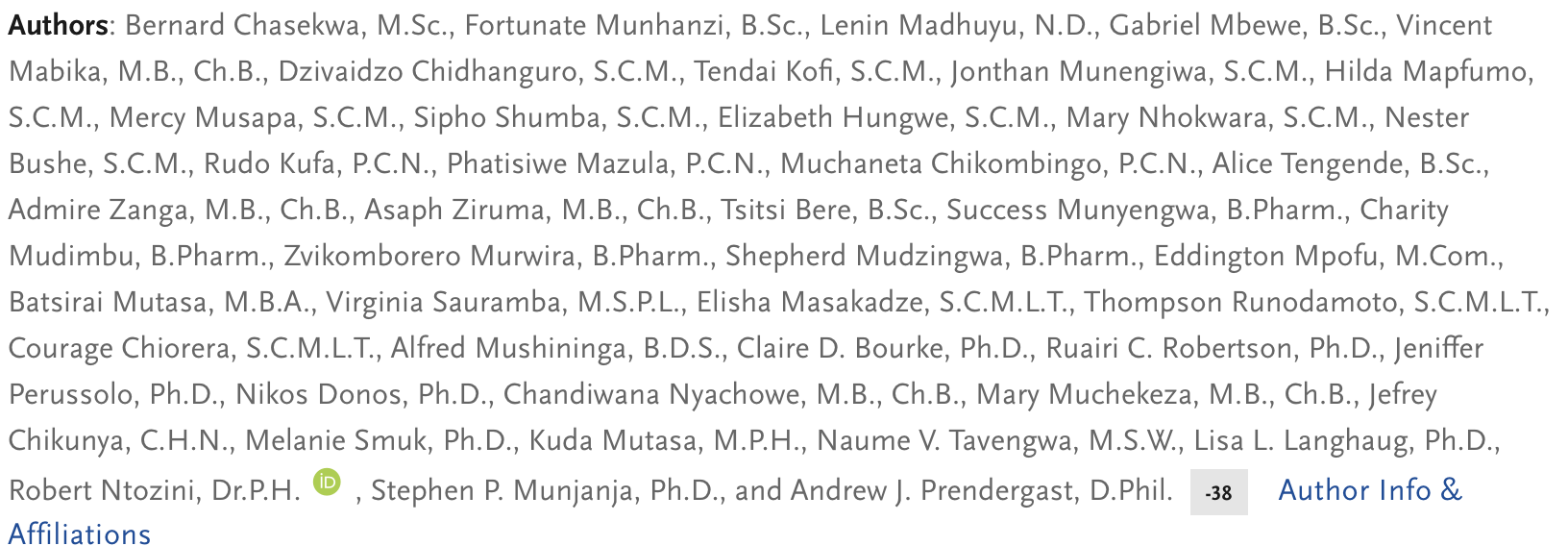
【The New England Journal of Medicine】
2025年5-6月刊论文导读
期刊介绍:
《新英格兰医学杂志》(The New England Journal of Medicine,简称NEJM),是由美国麻州医学协会所出版的世界一流的综合性医学期刊。发表与各医学专业相关的研究,以及关于医学伦理、公共卫生和医疗政策的文章。文章类型主要是临床研究、综述、病例报告和社论等。这一期刊对生物医学科学与临床实践具有重要意义。该刊创刊于1812年,为周刊,最新影响因子为158.5。本期文献导读将呈现2024年5月至2024年6月上旬的主要刊物内容。
May 1, 2025; Volume 392 (17): 1665-1768
在2025年5月1日,共发表18篇文章,其中包括3篇Perspective,4篇Original articles,1篇Clinical Practice,1篇Videos in Clinical Medicine,2篇Images in clinical medicine,1篇Clinical problem-solving,1篇Clinical decision,1篇Special report,4篇Correspondence。
1.Identification of Hepatic-like EPO as a Cause of Polycythemia

AFFILIATIONS
1 Laboratoire Antidopage Français, Université Paris-Saclay, Orsay, France.
2 Section of Medicine, Department of Endocrinology, Metabolism, and Cardiovascular System, University of Fribourg, Fribourg, Switzerland.
3 National Center of Competence in Research Kidney Control of Homeostasis (Kidney.CH), Fribourg, Switzerland.
4 École Pratique des Hautes Études, Paris Sciences et Lettres Université, Paris.
5 Nantes Université, Centre Hospitalier Universitaire (CHU) Nantes, Centre National de la Recherche Scientifique (CNRS), INSERM, l'Institut du Thorax, Nantes, France.
6 Service d'Hématologie Biologique, Pôle Biologie, CHU de Dijon, Dijon, France.
7 Filière de Santé des Maladies Constitutionnelles Rares du Globule Rouge et de l'Erythropoïèse, Créteil, France.
8 INSERM Unité Mixte de Recherche 1287, Villejuif, France.
9 Gustave Roussy, Villejuif, France.
10 Département de Génétique Médicale, Assistance Publique-Hôpitaux de Paris (AP-HP), Sorbonne Université, Hôpital Pitié-Salpêtrière, Paris.
11 Paris-Saclay University, INSERM Unité 1287, Villejuif, France.
12 France Intergroup des Syndromes Myéloprolifératifs, Paris.
13 Service de Génétique Médicale, CHU de Nantes, Nantes, France.
14 Sorbonne Université, INSERM, Centre de Recherche Saint-Antoine, Paris.
15 Nantes Université, CHU Nantes, CNRS, INSERM, BioCore, Nantes, France.
16 Nantes Université, CHU Nantes, INSERM, Center for Research in Transplantation and Translational Immunology, Nantes, France.
17 Département de Biochimie-Biologie Moléculaire, Pharmacologie, Génétique Médicale, and Red Cell Disease Referral Center, Unité des Maladies Génétiques du Globule Rouge, Université Paris-Est Créteil, AP-HP, Hôpitaux Universitaires Henri Mondor, Creteil, France.
18 Université Paris-Est Créteil, Mondor Institute for Biomedical Research Equipe Pirenne, Laboratoire d'Excellence GR-Ex, Creteil, France.
19 Service de Médecine Interne, Centre Hospitalier de Mâcon, Mâcon, France.
20 Department of Pediatric Hematology and Immunology Child Hospital, University Hospital of Toulouse, Toulouse, France.
21 Centre de Recherche en Cancérologie de Toulouse, Team Impact des Altérations Génétiques sur le Développement des Leucémies Aiguës, INSERM Unité 1037, Institut Universitaire du Cancer de Toulouse-Oncopole, Toulouse, France.
22 Internal Medicine Department, Toulouse University Hospital, Toulouse, France.
23 Hématologie Clinique, Hôpital Avicenne, AP-HP, Hôpitaux Universitaires Paris Seine Saint-Denis, Bobigny, France.
24 Département d'Immunologie-Hématologie, Université de Paris and Sorbonne Paris Nord, Villetaneuse, France.
25 Service de Pédiatrie, Hématologie Bénigne, Hôpital Bicêtre, Université Paris-Saclay, Le Kremlin-Bicêtre, France.
26 Service d'Hématologie, CHU Nantes, Nantes, France.
27 Onco-hématologie Pédiatrique, Centre Hospitalier du Mans, Le Mans, France.
28 Immuno-hématologie Pédiatrique, Hôpital Robert-Debré, Université Paris-Cité, Paris.
29 Department of Pediatric Hematology, Gazi University Faculty of Medicine, Ankara, Turkey.
30 Réanimation Néonatale, Service de Pédiatrie, CHU Dijon, France.
31 Laboratoire d'Hématologie, CHU de Bordeaux, Bordeaux, France.
32 Laboratoire de Cytologie Clinique et Cytogénétique, Laboratoires de Biologie Médicale de Référence, Néoplasies Myéloprolifératives, CHU Caremeau, Nimes, France.
33 Service d'Hématologie, CHU Orléans, Orleans, France.
34 Institute of Clinical and Molecular Medicine, Norwegian University of Science and Technology, Trondheim, Norway.
35 Research Department, St. Olav's Hospital, Trondheim, Norway.
36 Nantes Université, CNRS, INSERM, Centre de Recherche en Cancérologie et Immunologie Intégrée Nantes Angers, Nantes, France.
37 Laboratoire d'Excellence Immunotherapy-Graft-Oncology, Immuno-Onco-Greffe, Nantes, France.
38 Department of Pediatrics and Adolescent Medicine, Ulm University Medical Center, Ulm, Germany.
39 Center for Rare Hematopoietic Disorders and Immunodeficiencies, Ulm University Medical Center, Ulm, Germany.
40 German Center for Child and Adolescent Health partner site Ulm, Ulm, Germany.
41 Dan L. Duncan Comprehensive Cancer Center, Baylor College of Medicine, Houston.
42 Laboratoire d'Excellence GR-Ex, Paris.
43 INSERM Unité 1231, Université de Bourgogne, Dijon, France.Abstract
Abstract
Background
Secondary erythrocytosis often results from conditions that cause tissue hypoxia or an improper increase in erythropoietin (EPO) production. EPO, the major regulator of erythropoiesis, has a complex and tightly regulated expression during development, with a liver-to-kidney switch shortly after birth.
Methods:
The researchers identified six families with erythrocytosis that was associated with circulating EPO levels within the normal range and characterized as a novel molecular and functional entity. Researchers investigated the effect of the identified pathogenic variants using EPO promoter-driven luciferase reporter genes. Induced pluripotent stem cells (iPSCs) were generated from patient cells and differentiated into hepatocyte-like EPO-producing cells. Samples of circulating EPO from patients with hereditary erythrocytosis and from healthy newborns were analyzed by means of isoelectric focusing, and EPO activity was assessed.
Results
Three novel variants were identified in the noncoding regions of EPO. Experiments with reporter assays and iPSC-derived hepatocyte-like cells showed that the variants targeted previously uncharacterized regulatory elements of the gene, which, when the variants were present, showed high responsiveness to hypoxia. EPO samples from all the patients showed a modified isoelectric-focusing profile, identical to hepatic EPO that is expressed in premature neonates and in patients with acquired erythrocytosis associated with liver diseases. EPO that was purified from patient plasma and umbilical-cord blood samples showed enhanced EPO receptor signaling activity in vitro, which suggests a potential gain of function linked to the liver-type glycosylation of EPO.
Conclusions
Secondary erythrocytosis can be related to variants in EPO that lead to the production of hepatic-like EPO with an atypical glycosylation pattern and increased activity. (Funded by Région des Pays de la Loire and others; ClinicalTrials.gov number, NCT03957863.).
鉴定肝源性EPO作为红细胞增多症的病因
背景
继发性红细胞增多症通常由导致组织缺氧或促红细胞生成素(EPO)生成异常增加的疾病引起。EPO是红细胞生成的主要调节因子,其复杂的表达在发育过程中受到严格调控,出生后不久,其主要表达部位会从肝脏转换到肾脏。
方法
研究者发现了6个红细胞增多症家系,其红细胞增多症与循环EPO水平在正常范围内相关,并被认为代表一种新的分子和功能性疾病实体。研究者利用EPO启动子驱动的荧光素酶报告基因研究了这些已识别的致病变异的功能影响。研究者从患者细胞中生成诱导多能干细胞(iPSCs),并将其分化为类似肝细胞的EPO生成细胞。研究者通过等电聚焦分析了来自遗传性红细胞增多症患者和健康新生儿的循环EPO样本,并评估了EPO的活性。
结果
研究者在EPO的非编码区鉴定了3个新的变异。报告基因实验和iPSC来源的类肝细胞实验显示,这些变异靶向了之前未被描述的基因调控元件,并在缺氧条件下表现出高度活性。所有患者的EPO样本均显示出修饰后的等电聚焦图谱,与早产儿表达的肝源性EPO以及与肝脏疾病相关的获得性红细胞增多症患者的EPO相同。从患者血浆和脐带血样本中纯化的EPO在体外显示出增强的EPO受体信号传导活性,这表明这些变异导致了具有肝型糖基化修饰的EPO,并与其功能增强相关。
结论
继发性红细胞增多症可能与EPO中基因的变异有关,这些变异导致产生具有非典型糖基化模式和活性增强的肝源性EPO。
May 8, 2025; Volume 392 (18): 1769-1872
在2025年5月8日,共发表20篇文章,其中包括3篇Perspective,5篇Original articles,1篇Review article,2篇Images in clinical medicine,1篇Case records of the Massachusetts General Hospital, 3篇Editorials,5篇Correspondence。
2.A Randomized Trial of Automated Insulin Delivery in Type 2 Diabetes

AFFILIATIONS
1 Division of Endocrinology, Diabetes, Metabolism, and Nutrition, Department of Internal Medicine, Mayo Clinic, Rochester, MN.
2 Jaeb Center for Health Research, Tampa, FL.
3 Diabetes and Endocrine Treatment Specialists, Sandy, UT.
4 Rocky Mountain Clinical Research, Idaho Falls, ID.
5 Division of Endocrinology, Diabetes, and Nutrition, Baltimore VA Medical Center, Baltimore.
6 Division of Endocrinology, Emory University School of Medicine, Emory University, Atlanta.
7 Harold Schnitzer Diabetes Health Center, Oregon Health and Science University, Portland.
8 Mary and Dick Allen Diabetes Center, Hoag Memorial Hospital Presbyterian, Newport Beach, CA.
9 Division of Endocrinology, Metabolism, and Molecular Medicine, Feinberg School of Medicine, Northwestern University, Chicago.
10 Texas Diabetes and Endocrinology, Austin.
11 Division of Endocrinology, Henry Ford Health System, Detroit.
12 Division of Endocrinology, Center for Diabetes Technology, University of Virginia, Charlottesville.
13 Division of Endocrinology, Icahn School of Medicine at Mount Sinai, New York.
14 Division of Endocrinology, Diabetes, and Metabolism, Department of Medicine, SUNY Upstate Medical University, Syracuse, NY.
15 Boston Medical Center, Boston.
16 Division of Endocrinology, St. Joseph's Health Care, Lawson Health Research Institute, London, ON, Canada.
17 University of Washington School of Medicine, Seattle.
18 Rainier Clinical Research Center, Renton, WA.
19 Division of Endocrinology, Diabetes, and Metabolism, University of Pennsylvania Perelman School of Medicine, Philadelphia.
20 Research Institute of the McGill University Health Centre, Montreal.
21 UT Southwestern Medical Center, University of Texas, Southwestern, Dallas.
22 University Hospitals Cleveland Medical Center, Cleveland.
23 Tandem Diabetes Care, San Diego, CA.
Abstract
BACKGROUND
Automated insulin delivery (AID) systems have been shown to be beneficial for patients with type 1 diabetes, but data are needed from randomized, controlled trials regarding their role in the management of insulin-treated type 2 diabetes.
METHODS
In this 13-week, multicenter trial, adults with insulin-treated type 2 diabetes were randomly assigned in a 2:1 ratio to receive AID or to continue their pretrial insulin-delivery method (control group); both groups received continuous glucose monitoring (CGM). The primary outcome was the glycated hemoglobin level at 13 weeks.
Results
A total of 319 patients underwent randomization. Glycated hemoglobin levels decreased by 0.9 percentage points (from 8.2±1.4% at baseline to 7.3±0.9% at week 13) in the AID group and by 0.3 percentage points (from 8.1±1.2% to 7.7±1.1%) in the control group (mean adjusted difference, –0.6 percentage points; 95% confidence interval [CI], –0.8 to –0.4; P<0.001). The mean percentage of time that patients were in the target glucose range of 70 to 180 mg per deciliter increased from 48±24% to 64±16% in the AID group and from 51±21% to 52±21% in the control group (mean difference, 14 percentage points; 95% CI, 11 to 17; P<0.001). All other multiplicity-controlled CGM outcomes reflective of hyperglycemia that were measured were significantly better in the AID group than in the control group. The frequency of CGM-measured hypoglycemia was low in both groups. A severe hypoglycemia event occurred in one patient in the AID group.
Conclusions
In this 13-week, randomized, controlled trial involving adults with insulin-treated type 2 diabetes, AID was associated with a greater reduction in glycated hemoglobin levels than CGM alone.
2型糖尿病患者自动化胰岛素输送的随机试验
背景
自动化胰岛素输送(AID)系统已被证明对1型糖尿病患者有益,但关于其在胰岛素治疗的2型糖尿病管理中的作用,仍需要来自随机对照试验的数据支持。
方法
在这项为期13周的多中心试验中,接受胰岛素治疗的2型糖尿病成年患者按照2:1的比例随机分配至接受AID治疗组或继续使用试验前胰岛素输送方法(对照组);两组均接受连续血糖监测(CGM)。主要结局指标为13周时的糖化血红蛋白水平。
结果
共有319名患者接受了随机分组。AID组患者的糖化血红蛋白水平从基线时的8.2%±1.4%下降至第13周的7.3%±0.9%,对照组患者的糖化血红蛋白水平从8.1%±1.2%下降至7.7%±1.1%(调整后平均差异,-0.6个百分点;95%置信区间[CI],-0.8至-0.4;P<0.001)。AID组患者血糖处于目标范围(70至180 mg/dL)的时间百分比从48%±24%增加到64%±16%,而对照组患者从51%±21%增加到52%±21%(平均差异,14个百分点;95% CI,11至17;P<0.001)。所有其他反映高血糖的CGM多重控制结果在AID组均显著优于对照组。两组中CGM测量的低血糖发生率均较低。AID组中有一名患者发生了严重低血糖事件。
结论
在这项为期13周的随机对照试验中,对于接受胰岛素治疗的2型糖尿病成年患者,AID治疗相比对照组在降低糖化血红蛋白水平方面显示出更显著的效果。
May 15, 2025; Volume 392 (19): 1873-1976
在2025年5月15日,共发表21篇文章,其中包括4篇Perspective,5篇Original articles,1篇Review Article,3篇Images in clinical medicine,1篇Interactive Medical Case,1篇Case Records of the Massachusetts General Hospital,4篇Editorials,2篇Correspondence。
3.Second-Line Antiretroviral Therapy for Children Living with HIV in Africa

AFFILIATIONS
1 Makerere University, College of Health Sciences, School of Medicine, Department of Paediatrics and Child Health, Kampala, Uganda.
2 Joint Clinical Research Centre, Kampala, Uganda.
3 Faculty of Medicine and Health Sciences, University of Zimbabwe, Harare, Zimbabwe.
4 University of Zimbabwe Clinical Research Center, Harare, Zimbabwe.
5 Medical Research Council Clinical Trials Unit at University College London, London.
6 Joint Clinical Research Centre, Mbarara, Uganda.
7 University of Zambia, School of Medicine, Lusaka, Zambia.
8 Infectious Diseases Research Collaboration, Kampala, Uganda.
9 Department of Medicine, University of Cape Town, Cape Town, South Africa.
10 Radboudumc Institute for Medical Innovation, Radboud University Medical Center, Nijmegen, the Netherlands.
11 Joint Clinical Research Centre, Fort Portal, Uganda.
12 University Teaching Hospitals Children's Hospital, Lusaka, Zambia.
13 Mpilo Central Hospital, Bulawayo, Zimbabwe.
14 Arthur Davison Children's Hospital, Ndola, Zambia.
15 National University of Science and Technology (NUST), NUST Mpilo Hospital Complex, Bulawayo, Zimbabwe.
16 Centre for Health Economics, University of York, York, United Kingdom.
17 UCL Great Ormond Street Institute of Child Health, London.Abstract
Abstract
BACKGROUND
Children living with human immunodeficiency virus (HIV) have limited options for second-line antiretroviral therapy (ART).
METHODS
In this open-label trial with a 2-by-4 factorial design, researchers randomly assigned children with HIV who had first-line treatment failure to receive second-line therapy with tenofovir alafenamide fumarate (TAF)–emtricitabine or standard care (abacavir or zidovudine, plus lamivudine) as the backbone and dolutegravir or ritonavir-boosted darunavir, atazanavir, or lopinavir as the anchor drug. The primary outcome was a viral load of less than 400 copies per milliliter at 96 weeks. It was hypothesized that TAF–emtricitabine would be noninferior to standard care, that dolutegravir and ritonavir-boosted darunavir would each be superior to ritonavir-boosted lopinavir and atazanavir analyzed in combination, and that ritonavir-boosted atazanavir would be noninferior to ritonavir-boosted lopinavir. Safety was also assessed.
RESULTS
A total of 919 children underwent randomization; 458 were assigned to receive TAF–emtricitabine, and 461 to receive standard care. Assigned anchor drugs were dolutegravir (229 participants), ritonavir-boosted darunavir (232), ritonavir-boosted atazanavir (231), and ritonavir-boosted lopinavir (227). The median age of participants was 10 years, and 497 (54.1%) were male. The median viral load at baseline was 17,573 copies per milliliter. At week 96, TAF–emtricitabine was superior to standard care: the adjusted difference in the percentage of participants with a viral load of less than 400 copies per milliliter was 6.3 percentage points (95% confidence interval [CI], 2.0 to 10.6; P=0.004). Dolutegravir was superior to ritonavir-boosted lopinavir and atazanavir analyzed in combination (adjusted difference, 9.7 percentage points; 95% CI, 4.8 to 14.5; P<0.001), but ritonavir-boosted darunavir was not (adjusted difference, 5.6 percentage points; 95% CI, 0.3 to 11.0; P=0.04 [prespecified threshold, P=0.03]). Ritonavir-boosted atazanavir was noninferior to ritonavir-boosted lopinavir. One child died, and 29 (3.2%) had serious adverse events, with no significant between-group differences.
CONCLUSIONS
Second-line ART regimens including TAF–emtricitabine and dolutegravir were effective for children, with no evidence of safety concerns. Ritonavir-boosted darunavir was also effective.
非洲艾滋病毒感染儿童的二线抗逆转录病毒治疗
背景
感染人类免疫缺陷病毒(HIV)的儿童在二线抗逆转录病毒治疗(ART)方面可选择的药物有限。
方法
在这项开放标签、2×4因子设计的试验中,研究人员将一线治疗失败的HIV感染儿童随机分配至接受以替诺福韦艾拉酚胺富马酸(TAF)-恩曲他滨或标准治疗(阿巴卡韦或齐多夫韦,加上拉米夫定)作为主要药物,并配合多替拉韦或利托那韦增强的达芦那韦、阿扎那韦或洛匹那韦作为锚定药物的二线治疗。主要结局是96周时病毒载量低于每毫升400拷贝。研究者假设TAF-恩曲他滨不劣于标准治疗;多替拉韦和利托那韦增强的达芦那韦均优于利托那韦增强的洛匹那韦和阿扎那韦(联合分析);利托那韦增强的阿扎那韦不劣于利托那韦增强的洛匹那韦。同时评估了安全性。
结果
共有919名儿童接受了随机分组;458名被分配至接受TAF-恩曲他滨,461名接受标准治疗。分配的锚定药物为多替拉韦(229名参与者)、利托那韦增强的达芦那韦(232名)、利托那韦增强的阿扎那韦(231名)和利托那韦增强的洛匹那韦(227名)。参与者的中位年龄为10岁,其中497名(54.1%)为男性。基线时的中位病毒载量为每毫升17,573拷贝。在第96周,TAF-恩曲他滨优于标准治疗:病毒载量低于每毫升400拷贝的参与者百分比调整后差异为6.3个百分点(95%置信区间[CI],2.0至10.6;P = 0.004)。多替拉韦优于利托那韦增强的洛匹那韦和阿扎那韦(联合分析),调整后差异为9.7个百分点(95% CI,4.8至14.5;P < 0.001),但利托那韦增强的达芦那韦未达到预设的统计学显著性(调整后差异为5.6个百分点;95% CI,0.3至11.0;P = 0.04 [预设阈值,P = 0.03])。利托那韦增强的阿扎那韦不劣于利托那韦增强的洛匹那韦。1名儿童死亡,29名(3.2%)发生严重不良事件,各组之间无显著差异。
结论
包含TAF-恩曲他滨和多替拉韦的二线ART方案对儿童有效,且未发现安全性问题。利托那韦增强的达芦那韦也显示出良好的疗效。
4.Tolebrutinib versus Teriflunomide in Relapsing Multiple Sclerosis

AFFILIATIONS
1 St. Michael's Hospital, University of Toronto, Toronto.
2 McGill University, Montreal.
3 NeuroRx Research, Montreal.
4 Department of Neurology, Weill Institute for Neurosciences, University of California, San Francisco, San Francisco.
5 Department of Neurology, UMass Chan Medical School, Worcester, MA.
6 Department of Neurology, National Cancer Center, Goyang, South Korea.
7 Department of Health Sciences, University of Genoa, Genoa, Italy.
8 IRCCS Ospedale Policlinico San Martino, Genoa, Italy.
9 Sanofi, Cambridge, MA.
10 Sanofi, Chilly-Mazarin, France.
11 Department of Neurology and Neurophysiology, University of Freiburg, Freiburg, Germany.
12 Brain and Mind Center, University of Sydney, Sydney.
Abstract
BACKGROUND
Tolebrutinib is an oral, brain-penetrant, and bioactive Bruton’s tyrosine kinase inhibitor that modulates peripheral inflammation and persistent immune activation within the central nervous system, including disease-associated microglia and B cells. More data are needed on its efficacy and safety in treating relapsing multiple sclerosis.
METHODS
In two phase 3, double-blind, double-dummy, event-driven trials (GEMINI 1 and GEMINI 2), participants with relapsing multiple sclerosis were randomly assigned in a 1:1 ratio to receive tolebrutinib (60 mg once daily) or teriflunomide (14 mg once daily), each with matching placebo. The primary end point was the annualized relapse rate. The key secondary end point was confirmed worsening of disability that was sustained for at least 6 months, which was assessed in a time-to-event analysis that was pooled across trials.
Results
A total of 974 participants were enrolled in GEMINI 1, and 899 were enrolled in GEMINI 2. The median follow-up was 139 weeks. The annualized relapse rate in the tolebrutinib and teriflunomide groups was 0.13 and 0.12, respectively, in GEMINI 1 (rate ratio, 1.06; 95% confidence interval [CI], 0.81 to 1.39; P=0.67) and 0.11 and 0.11, respectively, in GEMINI 2 (rate ratio, 1.00; 95% CI, 0.75 to 1.32; P=0.98). The pooled percentage of participants with confirmed disability worsening sustained for at least 6 months was 8.3% with tolebrutinib and 11.3% with teriflunomide (hazard ratio, 0.71; 95% CI, 0.53 to 0.95; no formal hypothesis testing was conducted owing to the prespecified hierarchical testing plan, and the width of the confidence interval is not adjusted for multiple testing). The percentage of participants who had adverse events was similar in the two treatment groups, although the percentage with minor bleeding was higher in the tolebrutinib group than in the teriflunomide group (petechiae occurred in 4.5% vs. 0.3%, and heavy menses in 2.6% vs. 1.0%).
Conclusions
Tolebrutinib was not superior to teriflunomide in decreasing annualized relapse rates among participants with relapsing multiple sclerosis.
托莱布替尼与特立氟胺在复发性多发性硬化症中的对比研究
背景
托莱布替尼是一种口服的、能够穿透大脑的、具有生物活性的布鲁顿酪氨酸激酶抑制剂,能够调节外周炎症以及中枢神经系统内持续的免疫激活,包括与疾病相关的微胶质细胞和B细胞。目前还需要更多关于其在治疗复发性多发性硬化症中的有效性和安全性的数据。
方法
在两项3期、双盲、双模拟、事件驱动的试验(GEMINI 1和GEMINI 2)中,研究者将复发性多发性硬化症患者以1:1的比例随机分配接受托莱布替尼(每日一次60毫克)或特立氟胺(每日一次14毫克),每种药物均配有相应的安慰剂。主要终点是年化复发率。关键次要终点是持续至少6个月的残疾恶化情况,该指标通过时间至事件分析在两项试验中汇总评估。
结果
GEMINI 1共纳入974名参与者,GEMINI 2纳入899名参与者。中位随访时间为139周。在GEMINI 1中,托莱布替尼组和特立氟胺组的年化复发率分别为0.13和0.12(率比为1.06;95%置信区间[CI]为0.81至1.39;P = 0.67);在GEMINI 2中,两组的年化复发率均为0.11(率比为1.00;95% CI为0.75至1.32;P = 0.98)。汇总分析显示,托莱布替尼组和特立氟胺组分别有8.3%和11.3%的参与者出现持续至少6个月的残疾恶化(风险比为0.71;95% CI为0.53至0.95;由于预设的分层检验计划,未进行正式的假设检验,且置信区间的宽度未调整多重检验)。两组中出现不良事件的参与者比例相似,但托莱布替尼组出现轻微出血的比例高于特立氟胺组(出现瘀点的比例为4.5%对0.3%,月经过多的比例为2.6%对1.0%)。
结论
在降低复发性多发性硬化症患者年化复发率方面,托莱布替尼并未显示出优于特立氟胺的效果。
May 29, 2025; Volume 392 (20): 1977-2079
在2025年5月29日,共发表22篇文章,其中包括5篇Perspective,3篇Original articles,1篇Special Article,1篇 Clinical practice, 3篇Images in clinical medicine,1篇Case Records of the Massachusetts General Hospital,3篇Editorials,1篇Clinical implications of basic research,4篇Correspondence。
5.Oral Semaglutide and Cardiovascular Outcomes in High-Risk Type 2 Diabetes
 AFFILIATIONS
AFFILIATIONS
1 University of Texas Southwestern Medical Center, Dallas.
2 Parkland Health System, Dallas.
3 Clinic for Cardiology, Angiology, and Intensive Care Medicine, Rheinisch-Westfälische Technische Hochschule Aachen University, University Hospital Aachen, Aachen, Germany.
4 Department of Medicine, Division of Cardiology, Dalhousie University, Halifax, NS, Canada.
5 Institute of Cardiovascular Sciences, University College London, London.
6 Section of Endocrinology, Yale University School of Medicine, New Haven, CT.
7 Division of Endocrinology, Diabetes, and Clinical Nutrition, Oregon Health and Science University, Portland.
8 Kuratorium für Heimdialyse Kidney Center, Munich, Germany.
9 Friedrich Alexander University of Erlangen, Erlangen, Germany.
10 Department of Biostatistics, University of Washington, Seattle.
11 Imperial Clinical Trials Unit, Imperial College London, London.
12 Novo Nordisk, Søborg, Denmark.
13 Swansea University Medical School, Swansea, United Kingdom.
14 University of North Carolina School of Medicine, Chapel Hill.
Abstract
BACKGROUND
The cardiovascular safety of oral semaglutide, a glucagon-like peptide 1 receptor agonist, has been established in persons with type 2 diabetes and high cardiovascular risk. An assessment of the cardiovascular efficacy of oral semaglutide in persons with type 2 diabetes and atherosclerotic cardiovascular disease, chronic kidney disease, or both is needed.
METHODS
In this double-blind, placebo-controlled, event-driven, superiority trial, researchers randomly assigned participants who were 50 years of age or older, had type 2 diabetes with a glycated hemoglobin level of 6.5 to 10.0%, and had known atherosclerotic cardiovascular disease, chronic kidney disease, or both to receive either once-daily oral semaglutide (maximal dose, 14 mg) or placebo, in addition to standard care. The primary outcome was major adverse cardiovascular events (a composite of death from cardiovascular causes, nonfatal myocardial infarction, or nonfatal stroke), assessed in a time-to-first-event analysis. The confirmatory secondary outcomes included major kidney disease events (a five-point composite outcome).
RESULTS
Among the 9650 participants who had undergone randomization, the mean (±SD) follow-up was 47.5±10.9 months, and the median follow-up was 49.5 months. A primary-outcome event occurred in 579 of the 4825 participants (12.0%; incidence, 3.1 events per 100 person-years) in the oral semaglutide group, as compared with 668 of the 4825 participants (13.8%; incidence, 3.7 events per 100 person-years) in the placebo group (hazard ratio, 0.86; 95% confidence interval, 0.77 to 0.96; P=0.006). The results for the confirmatory secondary outcomes did not differ significantly between the two groups. The incidence of serious adverse events was 47.9% in the oral semaglutide group and 50.3% in the placebo group; the incidence of gastrointestinal disorders was 5.0% and 4.4%, respectively.
CONCLUSIONS
Among persons with type 2 diabetes and atherosclerotic cardiovascular disease, chronic kidney disease, or both, the use of oral semaglutide was associated with a significantly lower risk of major adverse cardiovascular events than placebo, without an increase in the incidence of serious adverse events.
口服司美格鲁肽与高危2型糖尿病患者的心血管结局
背景
口服司美格鲁肽是一种胰高血糖素样肽1(GLP-1)受体激动剂,其心血管安全性已在伴有高心血管风险的2型糖尿病患者中得到验证。然而,仍需评估口服司美格鲁肽在伴有动脉粥样硬化性心血管疾病、慢性肾病或两者兼有的2型糖尿病患者中的心血管疗效。
方法
在这项双盲、安慰剂对照、事件驱动的优效性试验中,研究者将50岁及以上、患有2型糖尿病(糖化血红蛋白水平在6.5%至10.0%之间)且已知患有动脉粥样硬化性心血管疾病、慢性肾病或两者兼有的参与者随机分配,接受每日一次口服司美格鲁肽(最大剂量14毫克)或安慰剂,同时继续接受标准治疗。主要终点是主要不良心血管事件(包括心血管原因死亡、非致死性心肌梗死或非致死性卒中的复合终点),通过首次事件发生时间分析进行评估。确认性次要终点包括主要肾脏疾病事件(五点复合终点)。
结果
在9650名接受随机分组的参与者中,平均(±标准差)随访时间为47.5±10.9个月,中位随访时间为49.5个月。在口服司美格鲁肽组的4825名参与者中,有579人(12.0%;发生率为每100人年3.1次)发生了主要终点事件,而安慰剂组的4825名参与者中有668人(13.8%;发生率为每100人年3.7次)发生了主要终点事件(风险比为0.86;95%置信区间为0.77至0.96;P=0.006)。两组之间的确认性次要终点结果没有显著差异。口服司美格鲁肽组的严重不良事件发生率为47.9%,安慰剂组为50.3%;胃肠道疾病的发生率分别为5.0%和4.4%。
结论
在伴有动脉粥样硬化性心血管疾病、慢性肾病或两者兼有的2型糖尿病患者中,口服司美格鲁肽相比安慰剂显著降低了主要不良心血管事件的风险,且未增加严重不良事件的发生率。
6.Sotatercept in Patients with Pulmonary Arterial Hypertension at High Risk for Death

AFFILIATIONS
1 Université Paris-Saclay, INSERM Unité Mixte de Recherche en Santé 999, Hypertension Pulmonaire, Physiopathologie et Innovation Thérapeutique, Service de Pneumologie et Soins Intensifs Respiratoires, Hôpital Bicêtre (Assistance Publique-Hôpitaux de Paris), European Reference Network for Rare Respiratory Diseases, Le Kremlin-Bicêtre, France.
2 Department of Internal Medicine, Division of Cardiovascular Medicine, University of Michigan, Ann Arbor.
3 Pulmonary Hypertension Program, University of Colorado, Anschutz Medical Campus, Aurora.
4 Department of Internal Medicine, Justus-Liebig University Giessen, Universities of Giessen and Marburg Lung Center and Institute for Lung Health, Members of the German Center for Lung Research, Giessen, Germany.
5 National Heart and Lung Institute, Imperial College London, London.
6 Division of Cardiovascular Medicine, George Washington University School of Medicine and Health Sciences, Washington, DC.
7 Pulmonary and Critical Care Medicine, Lahey Hospital and Medical Center, Burlington, MA.
8 Divisão de Pneumologia, Instituto do Coração, Hospital das Clínicas da Faculdade de Medicina da Universidade de São Paulo, São Paulo.
9 Pulmonary and Critical Care Medicine, Brigham and Woman's Hospital, Harvard Medical School, Boston.
10 Department of Clinical Internal, Anesthesiologic, and Cardiovascular Science, Sapienza University of Rome, Rome.
11 Department of Cardiology, and Cologne Cardiovascular Research Center, Medical Faculty, Heart Center, University Hospital Cologne, Cologne, Germany.
12 Merck, Rahway, NJ.
13 Department of Respiratory Medicine and Infectious Diseases, Hannover Medical School and Member of the German Center for Lung Research, Biomedical Research in End-Stage and Obstructive Lung Disease Hannover, Hannover, Germany.
Abstract
Background
Sotatercept improves exercise capacity and delays the time to clinical worsening in patients with World Health Organization (WHO) functional class II or III pulmonary arterial hypertension. The effects of add-on sotatercept in patients with advanced pulmonary arterial hypertension and a high risk of death are unclear.
Methods
In this phase 3 trial, researchers randomly assigned patients with pulmonary arterial hypertension (WHO functional class III or IV) and a high 1-year risk of death (Registry to Evaluate Early and Long-Term Pulmonary Arterial Hypertension Disease Management Lite 2 risk score, ≥9) who were receiving the maximum tolerated dose of background therapy to receive add-on sotatercept (starting dose, 0.3 mg per kilogram of body weight; escalated to target dose, 0.7 mg per kilogram) or placebo every 3 weeks. The primary end point was a composite of death from any cause, lung transplantation, or hospitalization (≥24 hours) for worsening pulmonary arterial hypertension, assessed in a time-to-first-event analysis.
Results
A total of 172 patients were included (86 each in the sotatercept and placebo groups). The trial was stopped early on the basis of the efficacy results of a prespecified interim analysis. At least one primary end-point event occurred in 15 patients (17.4%) in the sotatercept group and in 47 patients (54.7%) in the placebo group (hazard ratio, 0.24; 95% confidence interval, 0.13 to 0.43; P<0.001). Death from any cause occurred in 7 patients (8.1%) in the sotatercept group and in 13 patients (15.1%) in the placebo group; lung transplantation in 1 patient (1.2%) and 6 patients (7.0%), respectively; and hospitalization for worsening pulmonary arterial hypertension in 8 patients (9.3%) and 43 patients (50.0%). The most common adverse events with sotatercept were epistaxis and telangiectasia.
CONCLUSIONS
Among high-risk adults with pulmonary arterial hypertension who were receiving the maximum tolerated dose of background therapy, treatment with sotatercept resulted in a lower risk of a composite of death from any cause, lung transplantation, or hospitalization (≥24 hours) for worsening pulmonary arterial hypertension than placebo.
索塔西普用于高死亡风险的肺动脉高压患者
背景
索塔西普能够改善世界卫生组织(WHO)功能分级为II级或III级的肺动脉高压患者的运动能力和延缓临床恶化时间。然而,对于晚期肺动脉高压且高死亡风险患者(定义为1年死亡风险评分≥9分),索塔西普作为附加治疗的效果尚不明确。
方法
在这项3期试验中,将WHO功能分级为III级或IV级、1年死亡风险高的肺动脉高压患者(根据肺动脉高压疾病管理轻量版登记研究(REVEAL 2)风险评分≥9)随机分配至接受索塔西普附加治疗(起始剂量为体重每公斤0.3毫克,逐步增加至目标剂量每公斤0.7毫克)或安慰剂,每3周给药一次。主要终点是全因死亡、肺移植或因肺动脉高压恶化住院(≥24小时)的复合终点,通过首次事件发生时间分析进行评估。
结果
共纳入172名患者(索塔西普组和安慰剂组各86名)。基于预设中期分析的有效性结果,试验提前终止。索塔西普组有15名患者(17.4%)发生至少一次主要终点事件,而安慰剂组有47名患者(54.7%)发生(风险比为0.24;95%置信区间为0.13至0.43;P<0.001)。索塔西普组有7名患者(8.1%)发生全因死亡,安慰剂组有13名患者(15.1%);索塔西普组有1名患者(1.2%)接受肺移植,安慰剂组有6名患者(7.0%);索塔西普组有8名患者(9.3%)因肺动脉高压恶化住院,安慰剂组有43名患者(50.0%)。索塔西普最常见的不良事件为鼻出血和毛细血管扩张。
结论
在接受最大耐受剂量背景治疗的高风险肺动脉高压成人患者中,索塔西普治疗相较于安慰剂,显著降低了全因死亡、肺移植或因肺动脉高压恶化住院(≥24小时)的复合终点风险。
June 5, 2025; Volume 392 (21): 2081-2183
在2025年6月5日,共发表20篇文章,其中包括3篇Perspective,4篇Original articles,1篇Review article,2篇Images in clinical medicine,1篇Clinical problem-solving,2篇Editorials,1篇Clinical decisions,1篇Medicine and society, 5篇Correspondence。
7.Navigational Bronchoscopy or Transthoracic Needle Biopsy for Lung Nodules

AFFLIATIONS
1 Division of Allergy, Pulmonary, and Critical Care Medicine, Vanderbilt University Medical Center, Nashville.
2 Department of Thoracic Surgery, Vanderbilt University Medical Center, Nashville.
3 Section of Pulmonary and Critical Care, Nashville Veterans Affairs Hospital, Nashville.
4 Department of Radiology and Radiological Sciences, Vanderbilt University Medical Center, Nashville.
5 Department of Biostatistics, Vanderbilt University Medical Center, Nashville.
6 Division of Pulmonary and Critical Care Medicine, St. Luke's Health System, University of Missouri at Kansas City, Kansas City.
7 Division of Pulmonary, Critical Care, and Sleep Medicine, University Hospitals, Case Western Reserve University School of Medicine, Cleveland.
8 Vanderbilt Trial Innovation Center and Center for Learning Healthcare, Vanderbilt Institute for Clinical and Translational Research, Nashville.
9 Division of Pulmonary, Critical Care, Sleep Medicine, and Physiology, University of California at San Diego, La Jolla.
10 Vanderbilt University School of Engineering, Nashville.
11 Section of Thoracic Surgery, Nashville Veterans Affairs Hospital, Nashville.
12 Kootenai Clinic Lung and Asthma, Kootenai Health, Coeur d'Alene, ID.
13 Department of Pathology, Vanderbilt University Medical Center, Nashville.
14 Division of Pulmonary, Critical Care, and Sleep Medicine, Rush University Medical Center, Chicago.
15 Division of Pulmonary, Critical Care, and Sleep Medicine, Medical College of Wisconsin, Milwaukee.
16 Division of Pulmonary Medicine, Respiratory Institute, Cleveland Clinic, Cleveland.
17 Division of Pulmonary, Allergy, and Critical Care Medicine, Duke University School of Medicine, Durham, NC.
18 Chest and Lung Center, Ascension Saint Thomas, Nashville.
19 Division of Pulmonary and Critical Care, Northwestern Feinberg School of Medicine, Chicago.
20 Division of Pulmonary, Critical Care, Allergy, and Sleep Medicine, Medical University of South Carolina, Charleston.
21 Division of Pulmonary and Critical Care Medicine, Johns Hopkins University School of Medicine, Baltimore.
22 Oxford Respiratory Trials Unit, University of Oxford, Oxford, United Kingdom.
23 National Institute for Health and Care Research Oxford Biomedical Research Centre, Oxford, United Kingdom.
24 Chinese Academy of Medical Sciences Oxford Institute, University of Oxford, Oxford, United Kingdom.
Abstract
Background
Each year, millions of pulmonary nodules are identified incidentally or through lung cancer screening, and many involve biopsy to distinguish cancer from benign processes. Both navigational bronchoscopy and computed tomography–guided transthoracic needle biopsy are commonly used in patients undergoing biopsies of peripheral pulmonary nodules, but the relative diagnostic accuracy of these two approaches is unclear.
METHODS
In this multicenter, randomized, parallel-group, noninferiority trial, researchers assigned patients with an intermediate-risk or high-risk peripheral pulmonary nodule measuring 10 to 30 mm in diameter to undergo navigational bronchoscopy or transthoracic needle biopsy at seven centers across the United States. The primary outcome was diagnostic accuracy, which was defined as the percentage of patients with biopsies that showed a specific diagnosis (cancer or a specific benign condition) that was confirmed to be accurate through 12 months of clinical follow-up (nonferiority margin, 10 percentage points). Secondary outcomes included procedural complications such as the occurrence of pneumothorax
Results
Among the 234 patients included in the primary-outcome analysis (5 of whom were lost to follow-up), biopsy resulted in a specific diagnosis that was confirmed to be accurate through month 12 in 94 of 119 patients (79.0%) in the navigational bronchoscopy group and in 81 of 110 patients (73.6%) in the transthoracic needle biopsy group (absolute difference, 5.4 percentage points; 95% confidence interval, −6.5 to 17.2; P=0.003 for noninferiority; P=0.17 for superiority). Pneumothorax occurred in 4 of 121 patients (3.3%) in the navigational bronchoscopy group and in 32 of 113 patients (28.3%) in the transthoracic needle biopsy group and led to the placement of a chest tube, hospital admission, or both in 1 patient (0.8%) and 13 patients (11.5%), respectively.
Conclusions
The diagnostic accuracy of navigational bronchoscopy was noninferior to that of transthoracic needle biopsy among patients with peripheral pulmonary nodules measuring 10 to 30 mm.
导航支气管镜检查与经胸壁穿刺活检用于肺结节的诊断
背景
每年,数百万肺结节通过偶然发现或肺癌筛查被识别出来,其中许多需要进行活检以区分癌症和良性病变。导航支气管镜检查和CT引导的经胸壁穿刺活检常用于外周肺结节的活检患者,但这两种方法在诊断准确性方面的直接比较尚不充分。
方法
在这项多中心、随机、平行组、非劣效性试验中,研究者将美国七个中心的中高风险外周肺结节(直径10至30毫米)患者随机分配至接受导航支气管镜检查或经胸壁穿刺活检。主要结局是诊断准确性,定义为通过12个月的临床随访确认为准确的特定诊断(癌症或特定良性病变)的患者百分比(非劣效性边界为10个百分点)。次要结局包括程序相关并发症,如气胸的发生。
结果
在234名纳入主要结局分析的患者中(其中5名失访),导航支气管镜组119名患者中有94名(79.0%)和经胸壁穿刺活检组110名患者中有81名(73.6%)的活检结果显示特定诊断在第12个月被确认为准确(绝对差异为5.4个百分点;95%置信区间为-6.5至17.2;非劣效性P = 0.003;优越性P = 0.17)。导航支气管镜组121名患者中有4名(3.3%)和经胸壁穿刺活检组113名患者中有32名(28.3%)发生气胸,分别导致1名(0.8%)和13名(11.5%)患者需要放置胸腔引流管、住院或两者兼有。
结论
对于直径为10至30毫米的外周肺结节患者,导航支气管镜检查的诊断准确性不劣于经胸壁穿刺活检。
8.A Trial of Trimethoprim–Sulfamethoxazole in Pregnancy to Improve Birth Outcomes

AFFLIATIONS
1 Zvitambo Institute for Maternal and Child Health Research, Harare, Zimbabwe.
2 Blizard Institute, Queen Mary University of London, London.
3 Ministry of Health and Child Care, Harare, Zimbabwe.
4 University of Zimbabwe, Harare.
5 University of Zimbabwe Clinical Research Centre, Harare.
6 University of Glasgow, Glasgow, United Kingdom.
7 Centre for Oral Clinical Research, Institute of Dentistry, Faculty of Medicine and Dentistry, Queen Mary University of London, London.
Abstract
BACKGROUND
Maternal infections underlie several adverse birth outcomes. Whether trimethoprim–sulfamethoxazole prophylaxis during pregnancy will improve birth outcomes is unknown.
METHODS
In a double-blind, randomized, placebo-controlled trial in Zimbabwe, researchers assigned pregnant women to receive trimethoprim–sulfamethoxazole, at a dose of 960 mg daily, or placebo from at least 14 weeks’ gestation until delivery. The primary outcome was birth weight.
RESULTS
Among 993 participants (131 with human immunodeficiency virus infection), 498 were randomly assigned to receive placebo and 495 to receive trimethoprim–sulfamethoxazole, with the first dose received at a median of 21.7 weeks’ gestation (interquartile range, 17.3 to 26.4). In intention-to-treat analyses, the mean (±SD) birth weight was 3040±460 g in the trimethoprim–sulfamethoxazole group and 3019±526 g in the placebo group (mean difference, 20 g, 95% confidence interval, −43 to 83; P=0.53). The number of adverse events was similar in the two groups.
CONCLUSIONS
In Zimbabwe, trimethoprim–sulfamethoxazole prophylaxis during pregnancy did not significantly increase infant birth weight.
复方新诺明孕期改善出生结局的研究
背景
母体感染是许多不良出生结局的潜在原因。然而,目前尚不清楚孕期使用复方新诺明(trimethoprim-sulfamethoxazole)预防是否能够改善出生结局。
方法
在津巴布韦进行的一项双盲、随机、安慰剂对照试验中,研究者将孕妇随机分配,自至少妊娠14周起至分娩期间,每日接受960毫克复方新诺明或安慰剂治疗。主要结局指标为出生体重。
结果
在993名参与者中(其中131名为人类免疫缺陷病毒[HIV]感染者),498名被随机分配至安慰剂组,495名分配至复方新诺明组,首次服药时的中位妊娠时间为21.7周(四分位间距,17.3至26.4周)。在意向性治疗分析中,复方新诺明组婴儿的平均(±标准差)出生体重为3040±460克,安慰剂组为3019±526克(平均差异,20克;95%置信区间,-43至83;P = 0.53)。两组中不良事件的发生数量相似。
结论
在津巴布韦,孕期预防性使用复方新诺明并未显著增加婴儿的出生体重。
June 12, 2025;Volume 392 (22):2185-2288
在2025年6月12日,共发表21篇文章,其中包括3篇Perspective,5篇Original articles,1篇Review article,2篇Images in clinical medicine,1篇Case records of the Massachusetts General Hospital,4篇Editorials,1篇Medicine and society,4篇Correspondence。
9.Once-Weekly Mazdutide in Chinese Adults with Obesity or Overweight

AFFILIATIONS
1 Department of Endocrinology and Metabolism, Peking University People's Hospital, Beijing.
2 Department of Endocrinology, First Affiliated Hospital and Clinical Medicine College, Henan University of Science and Technology, Luoyang, China.
3 Department of Endocrinology, Affiliated Drum Tower Hospital, Medical School of Nanjing University, Nanjing, China.
4 Department of Cardiology, Zibo Municipal Hospital, Zibo, China.
5 Department of Endocrinology, Luoyang Third People's Hospital, Luoyang, China.
6 Department of Endocrinology, First Affiliated Hospital of Nanyang Medical College, Nanyang, China.
7 Department of Endocrinology, Fifth People's Hospital of Shenyang, Shenyang, China.
8 Department of Endocrinology, Huzhou Central Hospital, Huzhou, China.
9 Department of Endocrinology, People's Hospital of Xuancheng, Xuancheng, China.
10 Department of Endocrinology, Suzhou Municipal Hospital, Suzhou, China.
11 Department of Endocrinology, First People's Hospital of Kunshan, Kunshan, China.
12 Department of Endocrinology, China National Petroleum Corporation Central Hospital, Langfang.
13 Department of Endocrinology, Pingxiang People's Hospital, Pingxiang, China.
14 Department of Cardiology, Yan'an University Xianyang Hospital, Xianyang, China.
15 Department of Cardiology, China-Japan Union Hospital of Jilin University, Changchun, China.
16 Department of Cardiology, Lishui Central Hospital, Lishui, China.
17 Innovent Biologics, Suzhou, China.Abstract
Abstract
BACKGROUND
Evidence suggests that incretin-based dual agonist pharmacotherapy is helpful in persons with obesity. Mazdutide, a glucagon-like peptide-1 and glucagon receptor dual agonist, may have efficacy in persons with overweight or obesity.
METHODS
In a phase 3, double-blind, placebo-controlled trial in China, researchers randomly assigned, in a 1:1:1 ratio, adults 18 to 75 years of age who had a body-mass index (BMI; the weight in kilograms divided by the square of the height in meters) of at least 28 or had a BMI of 24 to less than 28 plus at least one weight-related coexisting condition to receive 4 mg of mazdutide, 6 mg of mazdutide, or placebo for 48 weeks. The two primary end points were the percentage change in body weight from baseline and a weight reduction of at least 5% at week 32, as assessed in a treatment-policy estimand analysis (which assessed effects regardless of early discontinuation of mazdutide or placebo and the initiation of new antiobesity therapies).
RESULTS
Among 610 participants, the mean body weight was 87.2 kg and the mean BMI was 31.1 at baseline. At week 32, the mean percentage change in body weight from baseline was –10.09% (95% confidence interval [CI], −11.15 to −9.04) in the 4-mg mazdutide group, –12.55% (95% CI, −13.64 to −11.45) in the 6-mg mazdutide group, and 0.45% (95% CI, −0.61 to 1.52) in the placebo group, and 73.9%, 82.0%, and 10.5% of the participants, respectively, had a weight reduction of at least 5% (P<0.001 for all comparisons with placebo). At week 48, the mean percentage change in body weight from baseline was –11.00% (95% CI, −12.27 to −9.73) in the 4-mg mazdutide group, –14.01% (95% CI, −15.36 to −12.66) in the 6-mg mazdutide group, and 0.30% (95% CI, −0.98 to 1.58) in the placebo group, and 35.7%, 49.5%, and 2.0% of the participants, respectively, had a weight reduction of at least 15% (P<0.001 for all comparisons with placebo). Beneficial effects on all prespecified cardiometabolic measures were seen with mazdutide. The most frequently reported adverse events were gastrointestinal and mostly mild to moderate in severity. The incidence of adverse events leading to discontinuation of the trial regimen was 1.5% with the 4-mg mazdutide dose, 0.5% with the 6-mg mazdutide dose, and 1.0% with placebo.
CONCLUSIONS
In Chinese adults with overweight or obesity, once-weekly mazdutide at a dose of 4 mg or 6 mg for 32 weeks led to clinically relevant reductions in body weight.
每周一次的玛仕度肽用于肥胖或超重的中国成年人
背景
证据表明,基于肠促胰岛素的双重激动剂药物治疗对肥胖人群有益。玛仕度肽是一种胰高血糖素样肽-1(GLP-1)和胰高血糖素受体双重激动剂,可能在超重或肥胖人群中具有良好疗效。
方法
在中国进行的一项3期、双盲、安慰剂对照试验中,研究者将18至75岁、体重指数(BMI)至少为28,或BMI在24至<28之间且至少有一种与体重相关共病的成年人随机分配(1:1:1比例),分别接受每周一次4毫克玛仕度肽、6毫克玛仕度肽或安慰剂治疗,持续48周。两个主要终点是从基线到第32周的体重百分比变化,以及第32周时体重至少减少5%的比例,通过治疗策略估计分析(treatment-policy estimand analysis)进行评估(无论是否提前停用玛仕度肽或安慰剂,以及是否开始新的抗肥胖治疗)。
结果
在610名参与者中,基线时的平均体重为87.2千克,平均BMI为31.1。在第32周,4毫克玛仕度肽组的体重从基线的平均百分比变化为-10.09%(95%置信区间[CI],-11.15至-9.04),6毫克玛仕度肽组为-12.55%(95% CI,-13.64至-11.45),安慰剂组为0.45%(95% CI,-0.61至1.52);分别有73.9%、82.0%和10.5%的参与者体重至少减少了5%(与安慰剂组的所有比较P<0.001)。在第48周,4毫克玛仕度肽组的体重从基线的平均百分比变化为-11.00%(95% CI,-12.27至-9.73),6毫克玛仕度肽组为-14.01%(95% CI,-15.36至-12.66),安慰剂组为0.30%(95% CI,-0.98至1.58);分别有35.7%、49.5%和2.0%的参与者体重至少减少了15%(与安慰剂组的所有比较P<0.001)。玛仕度肽对所有预先指定的心血管代谢指标均显示出有益效果。最常报告的不良事件为胃肠道相关,且大多为轻度至中度。导致试验方案中断的不良事件发生率在4毫克玛仕度肽剂量组为1.5%,6毫克玛仕度肽剂量组为0.5%,安慰剂组为1.0%。
结论
在中国超重或肥胖的成年人中,每周一次使用4毫克或6毫克剂量的玛仕度肽,在32周内显著降低体重,并具有临床意义。
10.Nerandomilast in Patients with Progressive Pulmonary Fibrosis
 AFFILIATIONS
AFFILIATIONS
1 Department of Pulmonary, Critical Care, and Sleep Medicine, Keck School of Medicine, University of Southern California, Los Angeles.
2 Section of Inflammation, Repair, and Development, National Heart and Lung Institute, Imperial College London, London.
3 Division of Rheumatology, McGovern Medical School, UTHealth Houston, Houston.
4 Clinical Research Center, Mihara General Hospital, Saitama, Japan.
5 Nippon Medical School, Tokyo.
6 National Reference Center for Rare Pulmonary Diseases, Louis Pradel Hospital, Hospices Civils de Lyon, Claude Bernard University Lyon 1, Unité Mixte de Recherche 754, European Reference Network for Rare Respiratory Diseases, Lyon, France.
7 Department of Rheumatology, Oslo University Hospital, Oslo.
8 Department of Rheumatology, University Hospital Zurich, University of Zurich, Zurich, Switzerland.
9 Center for Pulmonary Medicine, Department of Pneumology, Mainz University Medical Center, Mainz, Germany.
10 Pulmonary, Critical Care, and Sleep Medicine, Marienhaus Clinic Mainz, Mainz, Germany.
11 Pulmonary and Critical Care Medicine, University of Michigan, Ann Arbor.
12 Unità Operativa Complessa di Pneumologia, Fondazione Policlinico Universitario A. Gemelli IRCCS, Università Cattolica del Sacro Cuore, Rome.
13 Department of Pulmonology, Hospital Universitario de la Princesa, Universidad Autónoma de Madrid, Madrid.
14 Center of Expertise for Interstitial Lung Diseases, Department of Respiratory Medicine, Erasmus Medical Center, University Medical Center, Rotterdam, the Netherlands.
15 Therapy Area Inflammation Medicine, Boehringer Ingelheim International, Ingelheim am Rhein, Germany.
16 Boehringer Ingelheim, Brussels.
17 Global Biostatistics and Data Sciences, Boehringer Ingelheim Pharmaceuticals, Ridgefield, CT.
18 Clinical Development Operations, Boehringer Ingelheim, Amsterdam.
19 Global Biostatistics and Data Sciences, Boehringer Ingelheim Pharma, Ingelheim am Rhein, Germany.
20 Global Clinical Development and Medical Affairs, Boehringer Ingelheim Pharmaceuticals, Ridgefield, CT.
21 University of Massachusetts Chan Medical School-UMass Memorial Health System, Worcester.
Abstract
BACKGROUND
Nerandomilast (BI 1015550) is an orally administered preferential inhibitor of phosphodiesterase 4B with antifibrotic and immunomodulatory properties. Nerandomilast has been shown to slow the progression of idiopathic pulmonary fibrosis, but an assessment of its effects in other types of progressive pulmonary fibrosis is needed.
Methods
In a phase 3, double-blind trial, researchers randomly assigned patients with progressive pulmonary fibrosis in a 1:1:1 ratio to receive nerandomilast at a dose of 18 mg twice daily, nerandomilast at a dose of 9 mg twice daily, or placebo, with stratification according to background therapy (nintedanib vs. none) and fibrotic pattern on high-resolution computed tomography (usual interstitial pneumonia-like pattern vs. other patterns). The primary end point was the absolute change from baseline in the forced vital capacity (FVC), measured in milliliters, at week 52.
RESULTS
A total of 1176 patients received at least one dose of nerandomilast or placebo, of whom 43.5% were taking background nintedanib therapy at baseline. The adjusted mean change in the FVC at week 52 was −98.6 ml (95% confidence interval [CI], −123.7 to −73.4) in the nerandomilast 18-mg group, −84.6 ml (95% CI, −109.6 to −59.7) in the nerandomilast 9-mg group, and −165.8 ml (95% CI, −190.5 to −141.0) in the placebo group. The adjusted difference between the nerandomilast 18-mg group and the placebo group was 67.2 ml (95% CI, 31.9 to 102.5; P<0.001), and the adjusted difference between the nerandomilast 9-mg group and the placebo group was 81.1 ml (95% CI, 46.0 to 116.3; P<0.001). The most frequent adverse event was diarrhea, reported in 36.6% of the patients in the nerandomilast 18-mg group, 29.5% of those in the nerandomilast 9-mg group, and 24.7% of those in the placebo group. Serious adverse events occurred in similar percentages of patients in the trial groups.
CONCLUSIONS
In patients with progressive pulmonary fibrosis, treatment with nerandomilast led to a smaller decline in the FVC than placebo over a period of 52 weeks.
奈拉司他用于进展性肺纤维化患者
背景
奈拉司他(Nerandomilast,BI 1015550)是一种口服的、选择性抑制磷酸二酯酶4B的药物,兼具抗纤维化和免疫调节特性。研究表明,奈拉司他能够延缓特发性肺纤维化的进展,但其在其他类型的进展性肺纤维化中的效果尚需评估。
方法
在一项3期、双盲试验中,研究者将进展性肺纤维化患者按1:1:1的比例随机分配至接受奈拉司他18毫克每日两次、奈拉司他9毫克每日两次或安慰剂治疗,分层因素包括背景治疗(尼达尼布 vs. 无)和高分辨率CT上的纤维化模式(寻常型间质性肺炎样模式 vs. 其他模式)。主要终点是第52周时用力肺活量(FVC)从基线的绝对变化值(以毫升为单位)。
结果
共有1176名患者接受了至少一剂奈拉司他或安慰剂,其中43.5%的患者在基线时正在接受背景尼达尼布治疗。第52周时,奈拉司他18毫克组的FVC调整后平均变化值为-98.6毫升(95%置信区间[CI],-123.7至-73.4),奈拉司他9毫克组为-84.6毫升(95% CI,-109.6至-59.7),安慰剂组为-165.8毫升(95% CI,-190.5至-141.0)。奈拉司他18毫克组与安慰剂组之间的调整后差异为67.2毫升(95% CI,31.9至102.5;P<0.001),奈拉司他9毫克组与安慰剂组之间的调整后差异为81.1毫升(95% CI,46.0至116.3;P<0.001)。最常见的不良事件是腹泻,分别在奈拉司他18毫克组的36.6%、奈拉司他9毫克组的29.5%和安慰剂组的24.7%的患者中报告。各试验组中严重不良事件的发生率相似。
结论
在进展性肺纤维化患者中,与安慰剂相比,奈拉司他治疗在52周内显著减缓了用力肺活量(FVC)的下降。

导读人:刘敏
导师:郑芸
审核:王肖宇、邱轲、任建君



